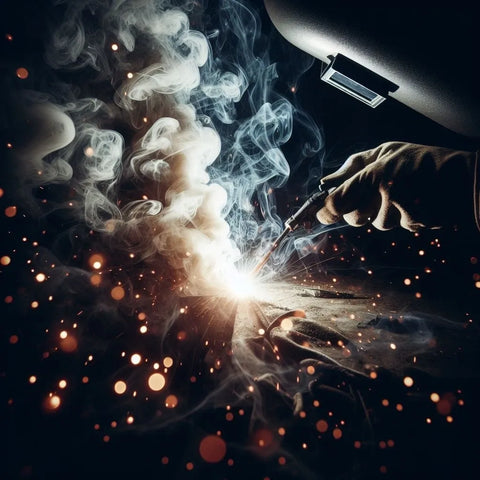Welding fumes and their hazards
Jan 15, 2024
Welding, a vital process in various industries, plays a crucial role in constructing bridges, manufacturing machinery, and assembling structures. While the sparks and glowing metal may be the most visually striking aspects of welding, there's an often overlooked and invisible danger lurking in the process – welding fumes. In this blog, we will explore the hazards associated with welding fumes, shedding light on the potential risks to both welders and those working in close proximity.

What is Welding Fumes
Welding fumes are airborne particles that result from the vaporization of metal during the welding process. These fumes contain a complex mixture of metals, oxides, and other compounds, depending on the type of metal being welded and the welding method employed. The most common metals present in welding fumes include manganese, chromium, nickel, and zinc.
These are the types and sources of welding fume:
|
Aluminium |
Aluminium component of some alloys, e.g., Inconels, copper, zinc, steel, magnesium, brass and filler materials. |
|
Beryllium |
Hardening agent found in copper, magnesium, aluminium alloys and electrical contacts. |
|
Cadmium Oxides |
Stainless steel containing cadmium or plated materials, zinc alloy. |
|
Chromium |
Most stainless-steel and high-alloy materials, welding rods. Also used as plating material. |
|
Copper |
Alloys such as Monel, brass, bronze. Also some welding rods. |
|
Fluorides |
Common electrode coating and flux material for both low- and high-alloy steels. |
|
Iron Oxides |
The major contaminant in all iron or steel welding processes. |
|
Lead |
Solder, brass and bronze alloys, primer/coating on steels. |
|
Manganese |
Most welding processes, especially high-tensile steels. |
|
Molybdenum |
Steel alloys, iron, stainless steel, nickel alloys. |
|
Nickel |
Stainless steel, Inconel, Monel, Hastelloy and other high-alloy materials, welding rods and plated steel. |
|
Vanadium |
Some steel alloys, iron, stainless steel, nickel alloys. |
|
Zinc |
Galvanized and painted metal. |
Are Welding Fumes Toxic?

Yes, welding fumes can be toxic. The process of welding generates fumes that contain various hazardous substances, including metal oxides, gases, and particulate matter. Inhaling these fumes can lead to health issues such as respiratory problems, lung damage, and other adverse effects. It's essential for individuals involved in welding activities to be aware of the potential toxicity of welding fumes and take appropriate measures, such as using proper ventilation and personal protective equipment, to minimize exposure and ensure a safe working environment.
What illnesses can welding fume cause?
-
Metal Fume Fever: This is a short-term illness caused by inhaling certain metal fumes, such as zinc. Symptoms include fever, chills, nausea, and muscle aches.
-
Pneumonia and Respiratory Infections: Inhaling welding fumes can increase the risk of respiratory infections and pneumonia, particularly if there is prolonged exposure to high concentrations of fumes.
-
Chronic Obstructive Pulmonary Disease (COPD): Long-term exposure to welding fumes has been linked to the development or worsening of COPD, a chronic lung disease that impairs airflow.
-
Occupational Asthma: Welding fumes may trigger or exacerbate asthma in individuals who are already predisposed to the condition.
-
Lung Cancer: Prolonged exposure to certain welding fumes, such as those containing carcinogenic metals like chromium and nickel, has been associated with an increased risk of lung cancer.
-
Manganese Poisoning: Welding on materials containing manganese can lead to manganese poisoning, causing neurological symptoms similar to Parkinson's disease.
-
Metal Toxicity: Depending on the metals present in welding fumes, exposure can lead to systemic toxicity affecting various organs, including the liver, kidneys, and nervous system.
It's crucial for individuals engaged in welding activities to follow safety protocols, use appropriate personal protective equipment (PPE), and work in well-ventilated areas to minimize the risk of these health issues. Regular health check-ups and monitoring are also recommended for those with occupational exposure to welding fumes.
Although welding helmets are not 100% effective in preventing welding smoke, they are also one of the indispensable pieces of equipment when welding. In addition, we have also launched two new styles of helmets for you to choose from.
Original Style

SSimder Auto Darkening True View Welding Helmet RLM-800
Upgraded Version

How to protect yourself from welding fumes
In comparison, TIG welding produces the least smoke, but this does not mean that they are completely non-toxic and harmless. MIG welding produces the second most smoke, and Stick welding produces the most smoke.

Fortunately, protecting yourself from welding fumes is easy to achieve, although many people don’t take their own safety seriously.
The most effective way is to weld outdoors and wear a protective mask, which has only one purpose: ventilation
-
Utilize a Respirator:
- Make sure to wear a respirator for protection against welding fumes.
-
Be Mindful of Air Flow:
- Position yourself so that you are not obstructing the natural air flow that pushes fumes away from your workspace.
-
Maximize Distance from Fumes:
- Keep your face positioned as far away from welding fumes as possible.
-
Enhance Ventilation with a Fan:
- If there's no natural air flow, consider using a small cooling fan to help disperse fumes from your workspace.
-
Employ Provided Ventilation Systems:
- Take advantage of any ventilation systems provided to minimize exposure to welding fumes.
-
Prep Metal Surfaces:
- Before welding, remove any coatings and paint from the metal to avoid the generation of additional toxic gases during the fusion process.
-
Confined Spaces and Respirators:
- In confined spaces lacking extraction ventilation or situations where welding fumes cannot be avoided, ensure to wear a respirator with effective filtration.
Frequently Asked Questions
What are the contaminants in welding fumes?
Welding fumes and their byproducts can potentially harm local ecosystems in several ways. The particles in the fumes can contaminate water sources if they settle on surfaces that come into contact with rainwater, which is then carried into streams, rivers, and lakes.
What heavy metals are in welding fumes?
The NIOSH criteria document identifies arsenic, beryllium, cadmium, chromium (IV), and nickel as potential human carcinogens that may be present in welding fumes.
How toxic are Aluminium welding fumes?
Health Risks of Aluminum Welding Fume Exposure
Exposure to fumed aluminum and aluminum oxides can cause both acute and chronic conditions ranging from lung disease to nervous system damage. Acute symptoms of aluminum weld fume exposure include: Irritation of the eyes, nose, throat, and lungs.
Is welding aluminum bad for your lungs?
When welding aluminum, inhaling these particles in the form of aluminum oxide, if excessive, can lead to respiratory and lung diseases, often in the form of bronchitis.
What happens if you inhale too much welding fumes?
Many studies report increased risk of lung cancer in welders or other workers exposed to welding fume. The International Association for Research on Cancer (IARC) conclude that all welding fume can cause lung cancer and may cause kidney cancer, classifying all welding fume as Group 1 carcinogenic substances.
Are welding fumes worse than cigarettes?
While both welding fumes and cigarette smoke are undeniably harmful, the extent of their impact varies based on exposure, duration, and specific substances involved. Welding fumes are particularly associated with an increased risk of lung cancer.



